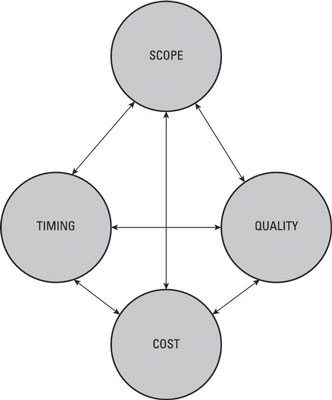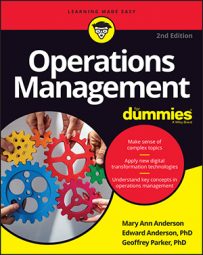Unlike processes, you don’t perform projects over and over again; they’re usually one-time efforts. The metrics of success for any operations management project depends on the objectives that the project is intended to meet. Yet many project leaders spend too little time before launching a project figuring out what they want to achieve. In some cases, this failure is a matter of interest; other times it’s a lack of resources.
When initiating a project, you need to figure out ahead of time what needs to be done, how much it’s likely to cost, what kind of time frame the effort requires, and how you can track the project’s progress toward its goals. These criteria may be helpful for launching a project plan.
Projects are generally evaluated against four criteria:
Scope: What exactly is the project supposed to accomplish in terms of goals and deliverables? And, maybe more important, what is it not trying to accomplish?
Timing: How long will it take to complete the project?
Cost: How much money will it cost to finish the project?
Quality: What does the project need to do well to achieve its goals?
Prioritize criteria
How important each of these criteria is to a particular project depends on the project. If you’re planning the construction of a new stadium for the Olympics, missing the deadline by a week is a disaster. If you’re planning the construction of a new playground by volunteers in a neighborhood park, missing the deadline by a week isn’t such a big deal. (After all, you get what you pay for!)
Similarly, missing the cost budget for an Olympic stadium by 50 percent may not be disastrous. For example, the Sydney Opera House is considered one of the great architectural wonders of the 20th century and is a UNESCO World Heritage Site. Its original budget was $7 million. When completed, it ended up costing approximately $100 million.
Thus, it was over budget by a factor of 14 times. While many complained about the overruns at the time, there was no rioting in the streets. On the other hand, overshooting the budget of a playground by a factor of 14 times just couldn’t happen because the project would be abandoned if costs ballooned to this degree. More important, you may never be invited to another neighborhood block party!
Quality is different from cost and timing. For starters, it’s not as easy to measure. Yet its impression is usually longer lasting. For example, Australia has mostly forgotten its cost and timing issues with the Sydney Opera House, yet it constantly trumpets the quality of the structure in terms of beauty and acoustics.
Moreover, missing quality targets, such as falling masonry in a tunnel project, can literally kill people. Even smaller issues, like a persistent leaking in a roof, can sour clients on a project because, unlike late completion or cost overruns, poor quality continues to haunt the client on an ongoing basis — long after the project is completed.
The point is that people often worry about cost and timing more than quality in the short run, but in the long run, quality becomes much more important.
We’re not suggesting that you plan on missing any of your project’s goals or success criteria. But realistically, if you have to trade off one criterion for another, be very clear which of them is more important, and be aware that this answer may be different in the long term versus the short term.
The interaction of factors
Bear in mind that the four factors for success (scope, timing, cost, and quality) interact and trade off against one another. For example, you can usually speed up a project if you’re willing to spend money on overtime and extra personnel. Similarly, you can always skimp on quality or scope to reduce cost or accelerate timing.
The project pyramid shows the interrelationships among scope, cost, timing, and quality. For example, if you’re willing to give up on building that third wing to your Hollywood mansion, your project costs are likely to go down.
One of the major jobs of the project manager is to juggle these four project success factors over the entire lifetime of the project.
At the start of a project, its cost, timing, and quality are estimates. Some folks argue that the reason many projects are late or over budget is because upfront estimates are too optimistic. Though this is certainly true in many cases, a reason that estimates are done poorly is because not enough effort was spent planning out the goals of the project. Thus, planning and goals are tightly interlinked.


